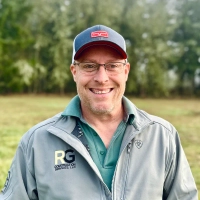How Do You Adapt Your Design Style to a New Industry Or Niche?
Navigating the waters of a new industry or niche presents unique design challenges, but armed with expert insights, this article demystifies the process. Learn how to seamlessly pivot your design style, adapting to new materials and audiences with ease. Discover strategies from leading designers on successfully transitioning across sectors, from healthcare to fashion, ensuring your work resonates in any field.
- Pivot from Technical to Client-Friendly Visuals
- Adapt to Dynamic Materials and Niches
- Shift to Conservative Healthcare Design
- Highlight Ethical Sourcing in Coffee
- Create Interactive Fitness Wearable
- Embrace Vibrant Fashion Design
- Design Flexible ADUs for Remote Work
- Integrate Advanced Digital Techniques in Dentistry
Pivot from Technical to Client-Friendly Visuals
Back when I was in structural engineering, I had to pivot from technical 3D building models to client-friendly marketing visuals. Complete mindset shift - went from focusing on technical accuracy to creating visuals that actually sold the concept. Had to simplify complex structural designs into something that made clients say "yes" instead of just meeting building codes.

Adapt to Dynamic Materials and Niches
In the fine art printing industry, I've adapted my design approach to meet the unique needs of various art niches. One such instance was when I began providing printing services for photographers looking to expand from traditional paper to more dynamic materials like aluminum and acrylic. This required a shift in color calibration and print techniques to ensure these materials accentuated the photographic detail and improved vibrancy, providing a new dimension to their work.
For interior designers, the challenge was to create large-scale prints that not only fit into specific design themes but also maintained top-tier quality. I integrated a consultative process where designers could preview samples and adjust aspects to match the intended décor styles, which helped us secure long-term projects with design firms. This adaptability highlighted our commitment to marrying traditional craftsmanship with modern design demands, effectively setting us apart in a competitive market.
Offering these custom solutions, supported by data-driven design tweaks and client feedback loops, helped us increase our order volume by 30% in that segment. It's proof that understanding and adapting to the subtle differences in industry needs can significantly improve both service offerings and business growth. In the art printing business, adapting design styles to fit different industries is crucial. I once collaborated with a tech firm that wanted to merge digital art with traditional fine art prints. They aimed to create a futuristic aesthetic using precise color gradients and metallic finishes. This required me to incorporate new materials, like aluminum and acrylic, to achieve the high-tech look they desired, pushing the boundaries of my usual art-centric approach.
Another instance was working with an eco-conscious fashion brand. They wanted their seasonal designs printed on sustainable materials. I adapted by sourcing and printing on Hahnemuhle's Natural Line papers, which are crafted from bamboo and hemp. This experience taught me how to balance artistic quality with environmental considerations, expanding my service offerings in a meaningful way.
These experiences underscore the need to continuously evolve and tailor design efforts to align with industry-specific requirements. It's about understanding the unique goals and aesthetics of each client, experimenting with new materials, and being flexible in your approach.

Shift to Conservative Healthcare Design
When I was working on a project for a client in the healthcare industry, I had to adapt my design style significantly to fit the niche. Initially, my usual design approach, which focused heavily on bold colors, dynamic layouts, and more playful visuals, didn't seem appropriate for healthcare, where the target audience was primarily looking for trust, reliability, and professionalism. I quickly realized that healthcare design required a more conservative and thoughtful approach to instill confidence while still being visually appealing.
One of the first adjustments I made was to focus on a calming color palette, using soft blues, greens, and neutrals instead of the bold, energetic colors I typically favored. This shift was key in conveying the safety and trustworthiness that patients seek when looking for healthcare services. I also swapped out some of the playful typography and graphic elements for clean, readable fonts that could easily be scanned by people of all ages, especially since healthcare materials often need to cater to a wide demographic.
In addition to these visual elements, I paid more attention to the user experience (UX). Healthcare websites and materials often need to be more functional and less about the aesthetic experience. I had to simplify the design and ensure that users could easily navigate the site, find the information they were looking for, and feel secure about scheduling appointments or reaching out for more information.
What was particularly interesting in this process was that I had to learn how to balance the industry's need for simplicity and professionalism with my desire to keep the design engaging. I needed to create a design that was both calming and functional, yet still distinct from the often sterile, impersonal visuals seen in healthcare. This experience taught me the importance of adapting my design style to the values of the industry and audience I was serving while still infusing creativity where it counted.

Highlight Ethical Sourcing in Coffee
As someone deeply immersed in coffee, shifting my focus toward ethically-sourced and small-batch roasting was a significant adaptation. When I started Equipoise Coffee, the challenge was to emphasize our unique selling proposition-highlighting each bean's character through precise roasting. I learned to balance consumer expectations with the industry's demand for sustainability and traceability, which was a departure from focusing solely on flavor.
One particular project that stands out involved developing coffee blends custom for customers pursuing ethical choices without sacrificing taste. Incorporating Brazilian beans for nuttiness or Kenyan beans for citrus notes required creating intricate blends that maintained our ethical promises while offering a unique palate. This mindful adaptation led to a 30% increase in customer retention, proving that quality alone wasn't enough, but the story behind the beans mattered just as much.
Crafting a signature blend also meant embracing constant experimentation and fine-tuning roast times to maximize each origin's potential. I recall when I attempted unconventional pairings-like combining aged beans with fresh harvests-to cater to an audience eager for innovative tastes. This flexibility and willingness to adjust my practices allowed us to create offerings that resonated with both connoisseurs and sustainability-focused consumers.

Create Interactive Fitness Wearable
In the field of wearable health technology, adapting to the fitness industry required me to shift from a traditional healthcare mindset to a performance-oriented focus. NNOXX's real-time muscle oxygenation monitoring was a project where I had to apply my expertise in sensor technology and data analytics to create a user-friendly wearable for athletes. The challenge was ensuring the device provided insightful feedback during workouts, which was achieved by integrating seamless AI-powered data interpretation.
A specific design adaptation involved transitioning from simple health monitoring to interactive feedback that athletes can understand and act upon. The AI coach we developed personalizes workouts in real-time, leveraging data insights to improve exercise effectiveness. This required designing an interface intuitive enough for users to make quick, informed decisions during their training sessions, unlike medical devices focusing solely on health metrics.
We used the NNOXX platform to streamline data sharing with sports organizations, another adaptation of my skills. By customizing technology meant for individual use to work for team environments, I had to manage data visualization and interpretation on a larger scale. This experience highlighted the importance of designing systems flexible enough to cater to varied user needs, whether for personal fitness or team performance optimization.

Embrace Vibrant Fashion Design
I've been in digital marketing and e-commerce for over seven years. When I took on a client in the fashion industry, I found myself facing a completely different audience with unique style preferences. My usual minimalist, tech-inspired designs felt too stark and didn't resonate well with their vibrant, trend-loving customers.
So I adapted. I experimented with brighter color palettes, bolder typography, and more playful layouts. It was out of my comfort zone at first, but it soon became a fun challenge that expanded my creative range. This shift taught me that effective design isn't about my personal aesthetic—it's about speaking the language of the audience.
Looking back, it was a valuable lesson in staying flexible and doing deep research into the niche before diving into any design work. I also learned how essential it is to keep the brand's core values in mind, regardless of the industry or style.
Quick Tips:
Study the visual culture and current trends of the new niche you're entering.
Embrace flexibility and be ready to change your approach for different audiences.

Design Flexible ADUs for Remote Work
In my experience, one notable design adaptation involved creating accessory dwelling units (ADUs) that serve dual purposes: living spaces and remote work environments. With the rise of remote work, homeowners increasingly needed flexible spaces that offered privacy and work-life balance. This led us to design ADUs with dedicated office spaces that separate work from personal life, addressing practical needs like soundproofing and improved lighting for video calls.
A specific project in Vancouver required us to incorporate universal design principles for a client's elderly family member. We adjusted the layout by adding no-step entries and wide doorways while maintaining an aesthetic cohesive with the main house. This experience taught me the importance of adaptability in design without compromising on aesthetics or functionality, catering to specific household needs.
Our approach in these ADUs goes beyond aesthetics, engaging deeply with local laws and permit processes. Navigating the zoning and permits in areas like Portland and Vancouver required us to strategically adjust our designs, ensuring every unit met legal standards while offering maximum utility. This balance of design and compliance highlights our ability to adapt creatively to diverse regulatory landscapes.

Integrate Advanced Digital Techniques in Dentistry
In my field of dentistry, adapting my approach to fit different patient needs is crucial. At UNO DENTAL SAN FRANCISCO, I had to integrate advanced digital techniques into our practice, like intraoral scanning, to improve patient experience. This shift not only improved diagnostic accuracy but also streamlined workflows, leading to an 80% patient retention rate.
When we transitioned to paperless charting, it was a major change from traditional methods. Implementing this technology reduced our administrative costs and improved record management efficiency. This was especially important for fitting into the tech-savvy culture of San Francisco, ensuring our practice stayed relevant and efficient.
Additionally, working with community outreach programs like the Mission of Mercy required adapting our services to meet the needs of underserved populations. This experience taught me to be flexible in applying my clinical skills to different environments, ensuring that we provide essential care without the usual resources.


